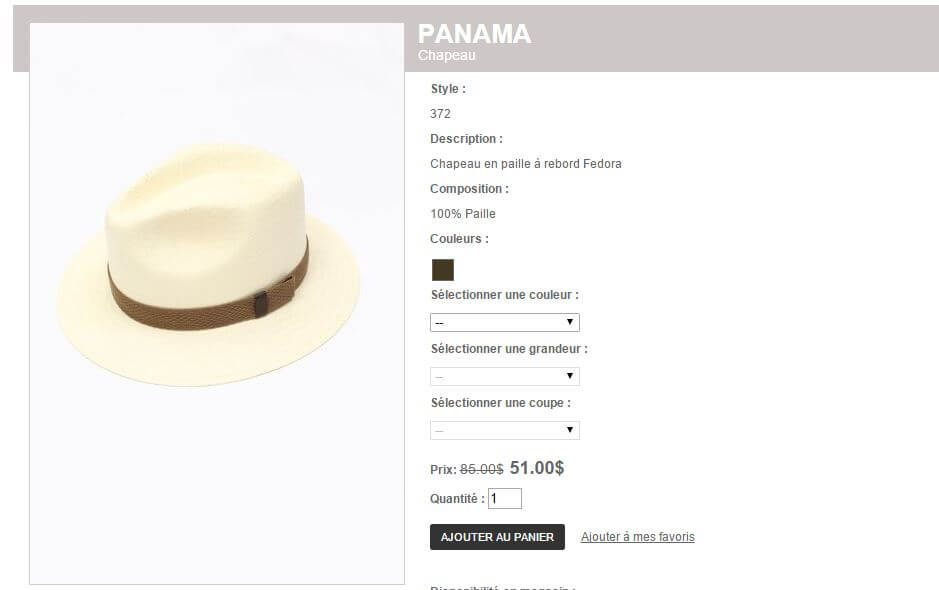Woocommerce continues to take a significant market share of online transactional stores in 2023. This article attempts to recall here the fundamentals of writing “product” sheets for E-commerce catalogs, as the on-page optimization requests that I audit show me a generalized lack of work on this type of Web pages, which are essential in the SEO strategy of E-commerce sites.
Whether it’s Prestashop, Magento, or extensions like Woocommerce for WordPress, all e-commerce CMSs integrate many functions that webmasters and web writers sometimes take advantage of.
This article goes a little beyond the simple writing framework that I develop in my Web optimization training . It reminds us of the technical and architectural bases on which an online store should be based.
I remind you that the “product” search engine can propel your sheets to the first page of results on Google
The H1 tag, the title of the page
The title tag of the card, tagged <H1> must identify the product by its brand, the name of the product, the precise reference and “what we use it for”, all in a few words… because it is indeed a title.
Fictional example: <h1>Brand #abc-56C Day Cream, firm the dermis day after day</h1>
The title tag <>
The 65 characters will be used to indicate:
The name of the product, its reference and its use in two words (expressed other than in the H1 tag) followed by the vertical bar and the Mark.
Fictional example:<title> Day cream #abc-56C the firmness of your skin regained | Marque</title>
Meta description
It will take up these elements in 165 characters, 230 since December 2017, by lengthening the “qualities” argument and promoting the “why-how” in order to encourage clicks in the series of results offered in the search engine response pages.
I will not give you a fictitious example
Product Overview
Very often, banal and neglected – the texts of product descriptions are often aggregated from a manufacturer’s database, including copy-pastes that run the Web, when they should be pampered.
The product description will be as long as possible, we will search for 150 words or more.
It can fit in a miter box or an accordion whose first drawer will be open by default. Each tab or drawer will receive an h2> tag <you will have control over the titles of these tabs or accordions.
Suggestion for example of drawers:
- Callout Marketing Description (open by default)
- Precise use of the product (why, circumstances of use, for whom)
- Ingredient, complete product composition, bottle size, origin
- Precautions for use and contraindications
- If it can be eaten: calories and other legal notices
This Product Overview text should contain links.
A link to its main product category and/or subcategory will almost always be placed by varying the anchor of the link.
From time to time (on priority promoted products) a link to the home page on a variant of the keywords searched for that Home page
Link redundancies
Generally speaking, redundant links will be placed in nofollow but always in favor of text links.
An external link will be placed on technical terms, names of substances in the composition, well-known people who use it, Youtube video of the product, Facebook or Google page that talks about it, etc.
Short description
The description corresponds to the excerpt of the articles, it will be adapted to the format left by the product category page because it will ideally be aggregated by each product in this page.
This contribution of content to the category, (often poor in this area), may only appear when hovering over the image, for example via a watermark, a bubble, a pop-up or any other trick that your graphic designer will propose.
This excerpt consists of a short (10-20 words) product presentation text but should be different at the same time:
- of the meta-description and
- the presentation text of the project.
You can afford to put a link on this entire mini text to the product page, in this case the link usually placed on the image will be in nofollow. (link redundancy)
Pagination, a call to action
It will send the visitor to a similar or complementary product according to your marketing options on text links.
The call to action will preferably be an untagged image and the link will be in nofollow, to avoid the classic and extreme redundancy of the word “cart”, “shop” and others…
Once again, generally speaking, redundant links will be placed in nofollow in favor of text links.
Product Image
On the image: Short but precise file name “product-name-ref”
On the Alt tag: product name, brand and technical reference
for complete information on image optimization
Breadcrumbs and URL consistency
The validity of the breadcrumb trail will be checked by going back step by step
We will check the validity of the store URLs by going up folder by folder, if you come across a 404 page at the root of the store (great classic!) it means that the e-store, your Woo Commerce module is set up “in a hurry”.
We will also check the coherence of these two elements, they must follow the same logic.
Check for product-related microformats: hProduct
Normally CMS and Ecommerce extensions are equipped with them by default, but they still need to be filled in.
The markup dedicated to products is not always retrieved by the SERP* (the SERP changes all the time…) but it contributes to the understanding of the content by search engines.
Products can be identified via properties like:
- name
- category
- price
- mark.
For Google to use this information, you must label your products by marking them with these properties.
For products, Google recognizes the following properties:
Hproduct
The root class name. All of your product’s content must be embedded in an element assigned to the required root property.
Fn
Contains the name of the product (text). Use the required fn property only once.
Brand
The optional brand property is used to identify the brand of the product. In some cases, it may be a manufacturer, in which case you will need to use an hCard.
Category
To specify the category of the product (such as clothing, movie, or video game), use the optional category property. It can be used multiple times in hProduct.
Note: you can also turn the content of categories into tags by creating links for each of them and adding the rel= “tag” property on the a’s<>.
Price
The optional price property specifies the price of the product. The content “price inside the assigned class=”price” element may appear in the format of the currency/currency. It is a number with a floating point written with a period and the price must remain unique.
Description
Use the optional description property to add content that describes the product.
Photo
You can assign the optional photo property, as many times as you want, for all images or links to images in your product content.
URL
The optional url property can be assigned to a link that redirects to a web page with detailed product information.
Note that there are other properties (identify or listing), not recognized by Google.
Reviews about the product
We will therefore implement a system for collecting reviews via an external service provider or as a resident solution.
Well now we’re really out of the Onpage, I’ll let your programmer tell you about it.
Tenfold increase in working time
I will also be told that with the changes in collections in certain professions, this optimization will only be sustainable for one season…
We should also add that when you sell a similar product in several variations, you have to be gifted not to repeat yourself in the creation of descriptions…
I know all this and I answer it in my web portal optimization mandates…
Product category pages and images.
Other related topics therefore useful for the consistency of your SEO optimization work
For the images
The category pages will respond to the recommendations of this article that I published in France.
SERP = Search Engine Response Page

